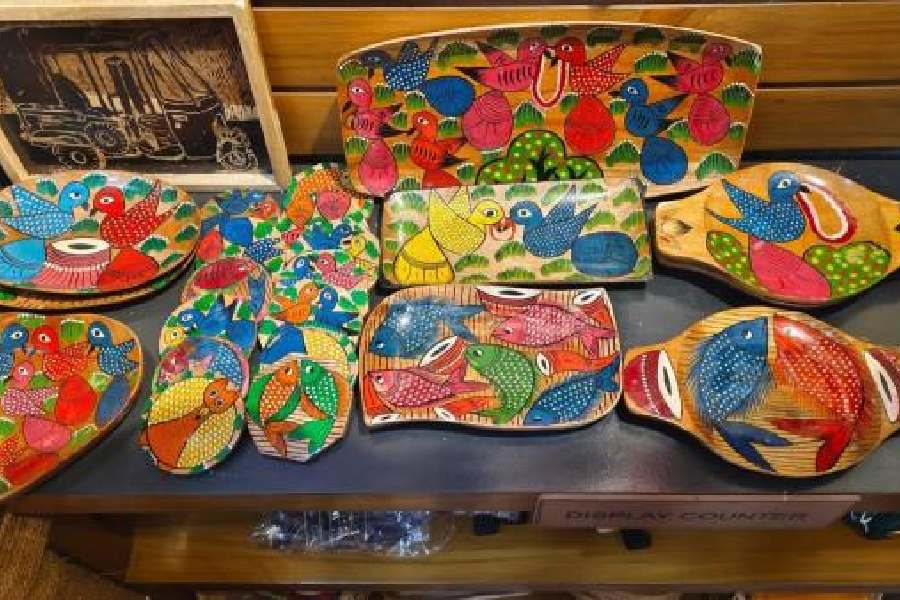In reviving a long-lost tradition of the Sunderbans, a campaign has also empowered a group of local women.
The women have been making a bouquet of products — key rings, coasters, lanterns, kettles, T-shirts and paintings. All of them draw from the scroll art (patachitra) of the Sunderbans.
As the campaign completes a year, much of the merchandise has been sold to buyers in and outside India.
It began with a four-month training programme, where over 30 women from villages around the Sunderbans Tiger Reserve (STR) were trained in scroll painting, which, organisers said, was once vibrant in the mangrove delta.
The training, which happened at Pakhiralay of STR under a professional Kolkata-based artist, was the first time most of the women picked up a brush or colours.
The training started in October last year and culminated in an exhibition at Sajnekhali in January this year. The month-long exhibition, held inside the Sajnekhali Wildlife Sanctuary, sold the products — postcards, kettles, lanterns and T-shirts — made by the
team of local women.
Since then, the products have been sold to multiple buyers. They have found their way to the US, UK, the Netherlands and studios in Mumbai and Goa.
A second-leg of the training with another group — of 25 women — is now set to begin at Jharkhali on November 1.
Patachitra, or cloth-based scroll painting, is one of the oldest folk art forms of Bengal. The content on the scroll ranges from mythological lore and folk tales to social sagas. Back in the days, patuas would carry the scrolls to village fairs and sing the stories painted on them.
The patachitra of Kalighat and Midnapore are well known. But the form once thrived in the Sunderbans as well. The patachitra of the Sunderbans drew from the tales of local legends like the Bon Bibi (the protector of humans and the forest) and the tiger.
But the absence of a sustainable revenue model and the geographical location of the mangrove delta possibly led to the decline of the tradition.
“The response has been fairly encouraging. Till now, we have been able to sell over 6,000 products. The combined worth is over Rs 5 lakh. Several women have started considering this as a mode of steady income,” said Sourav Mukherjee of the Kolkata Society for Cultural Heritage, the NGO behind the project.
A key ring costs Rs 25 and a T-shirt starts from around Rs 300.
Twenty-two women were selected from the training. But only around 10 women are still part of the project.
The earnings from the sale of the products are distributed among them.
Himadri Karmakar, a Mumbai-based exporter who also co-owns a studio in Colaba in Mumbai and another in south Goa, is a bulk buyer of the scroll merchandise. “My clients in the US and UK are happy with the products. I have also stacked up my studios with the merchandise,” said Karmakar.
The organisers of a Durga Puja in Almere, in the heart of the Flevoland province of the Netherlands, had also ordered scroll-inspired paintings and merchandise to adorn the venue.
“Additionally, the committee of Almere Durga Puja gifted some of those artefacts to the head of city marketing in Almere. A tea set with the Bon Bibi pala now adorns the office of Nik Smit, the head of Almere city marketing,” Satarupa Bose Roy, one of the organisers, said.
A puja in Salt Lake also bought several products, including a couple of scrolls.
Chinmoy Mukhopadhyay, a contemporary artist and illustrator focussed on Bengal folk art, who had trained the women in the last workshop, will be back training the new batch. Helping him will be some of the women who had trained under him in Sajnekhali and have been making the products.
Binapani Halder, who lives in a village in Jharkhali, is one of them. Her husband, who used to make a living as a fisherman, is now ailing. She has earned a little over Rs 15,000 since being a part of this project.
“I have a school-going son. The money has helped me sustain my family,” she said.
